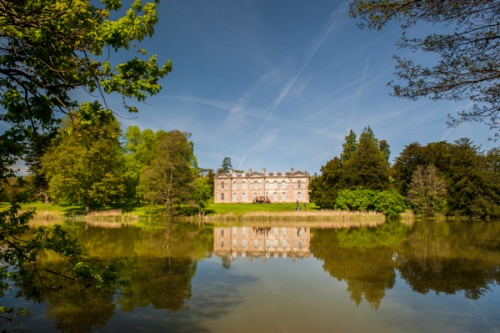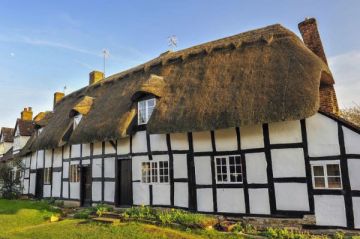
Summary
Compton Verney is an award-winning art gallery located in a beautiful Grade I listed mansion built by Robert Adam. The house is set in over 120 acres of landscaped grounds designed by Capability Brown. Within the gallery are 6 permanent exhibits and a changing array of temporary exhibitions.

The House
There was a manor at Compton Verney at least as early as 1150. At that time the local village was known as Compton Murdak. The estate was for a short period in the possession of Alice Ferrers, mistress of Edward III, but in 1453 it was sold to Richard Verney. The manor, and the house built by the Verney family, became known as Compton Verney.
The original house was altered and expanded over the centuries, but in 1711 George Verney, 12th Baron Willoughby de Broke, decided to rebuild the house in classical style, as was the current fashion.
The 12th Baron's house may have been influenced by Blenheim Palace, and it is possible that Sir John Vanbrugh, the architect of Blenheim, had a hand in Compton Verney. Some years later, in 1735, James Gibb was called in to design the stable block.
The new house was set in grand formal gardens in Baroque style, but this was not to last, for when John Verney, the 4th Baron, came to the title, he called in Scottish architect Robert Adam to rebuild the house again. This Adam did in some style, sweeping away the courtyard house in favour of a U-shaped design with a grand classical porticoed entrance.

Adam was responsible for only a few of the interior rooms; the remainder was finished by local craftsmen working from design pattern books.
In 1769 famed landscape garden designer Capability Brown was called in to remodel Compton Verney's grounds. This he did by ridding the house of its formal gardens and planting over 2200 oak trees to augment his sweeping vistas. Brown also designed the chapel, where the family tombs can still be seen.
The house was used by the army during WWII, but by the 1980's it had lapsed into a semi-derelict state. It was purchased by the Compton Verney House Trust in 1993, and under the care of the trust, it has been the recipient of an extensive programme of restoration and rebuilding.
The Galleries
There are 6 permanent exhibitions at Compton Verney. These are:
- Medieval Germanic art; 1450-1650
- Naples - art from the Golden Age of Neapolitan art; 1600-1800.
- Chinese bronzes dating as far back as the Neolithic period
- British Portraits, especially strong in the Tudor period
- Folk Art from Britain - the largest single collection in the UK
- Marx-Lambert collection of 20th century textiles and collectibles

In addition to the permanent exhibits, Compton Verney hosts a changing calendar of temporary art exhibitions. Some recent exhibitions include Landscapes from the Royal Academy of Arts, Women as portrayed in Impressionist art, and Van Gogh and the British. When we visited there was an exhibition of sculpture by August Rodin and Henry Moore, with many of the larger works placed at strategic viewpoints around the grounds, creating a wonderful natural setting for the artwork.
A big part of the appeal of Compton Verney - aside from its superb pastoral setting - is its ongoing programme of classes, workshops, and learning experiences for schools, families, and adults. The house and grounds are also available for social events such as weddings, meetings, concerts, and training sessions. For details see the official website (below).
The Chapel
Behind the house is Compton Verney chapel, built by Capability Brown in 1776. Brown demolished the medieval chapel beside the lake in 1772 as part of his landscape garden designs, but erected a new chapel in neo-classical style, bringing many of the older family monuments to the new building. There are medieval and later brasses, but the chapel is dominated by a large altar tomb of Richard and Margaret Verney, sculpted by Nicholas Stone around 1631.



British Portrait Gallery
About Compton Verney Art Gallery
Address: Compton Verney,
Warwickshire,
England, CV35 9HZ
Attraction Type: Museum
Location: Located 12 miles from Leamington Spa, on the B4086 between Wellesbourne and Kineton, and 6 miles from J12 of the M40.
Website: Compton Verney Art Gallery
Historic Houses Association
Location
map
OS: SP310805
Photo Credit: David Ross and Britain Express
POPULAR POSTS
HERITAGE
 We've 'tagged' this attraction information to help you find related historic attractions and learn more about major time periods mentioned.
We've 'tagged' this attraction information to help you find related historic attractions and learn more about major time periods mentioned.
Historic Time Periods:
Find other attractions tagged with:
Capability Brown (Person) - Edward III (Person) - John Vanbrugh (Person) - Medieval (Time Period) - Neolithic (Architecture) - Restoration (Historical Reference) - Robert Adam (Person) - Tudor (Time Period) -
NEARBY HISTORIC ATTRACTIONS
Heritage Rated from 1- 5 (low to exceptional) on historic interest
Compton Verney Chapel - 0 miles (Historic Church) ![]()
Chadshunt, All Saints Church - 2.3 miles (Historic Church) ![]()
British Motor Museum - 2.9 miles (Museum) ![]()
Charlecote Park - 3.6 miles (Historic House) ![]()
Hampton Lucy, St Peter ad Vincula Church - 4.3 miles (Historic Church) ![]()
Oxhill, St Lawrence Church - 4.6 miles (Historic Church) ![]()
Whatcote, St Peter's Church - 5.2 miles (Historic Church) ![]()
Halford, St Mary's Church - 5.5 miles (Historic Church) ![]()
Nearest Holiday Cottages to Compton Verney Art Gallery:
More self catering near Compton Verney Art Gallery








